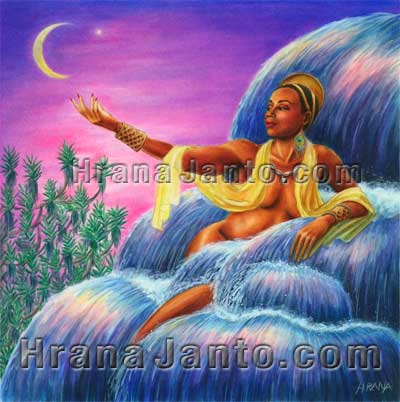 |
|
PREVIOUS | NEXT | A,B,C, D,E, F,G,H,I, J,K,L,M, N,O,P,Q, R,S, T,U,V,W,X,Y,Z | Help | ALL | INDEX
| Oshun from Goddesses and Heroines |
Exerpt from Goddess & Heroines by Patricia
Monaghan [Used by permission. This text is NOT included in the Goddess Oracle] |
Originally the Yoruba goddess of the river named for her, Oshun's emblem is the brass bracelet worn by her worshipers, and a pottery dish filled with white stones from a river's bed. In her African homeland, Oshun mated with the god Chango, with whom she had human children. Their descendents, who still live along her waters, are forbidden to eat snails or beans, or to drink beer made from sorghum.
Oshun is still honored in Nigeria with an annual ceremony called Ibo-Osun. A feast of yams begins the evening, then women dance for the goddess, hoping to be chosen as one of her favorites. Those who are selected are granted new names which include that of the goddess: Osun Leye, "gift of Oshun," or Osun Tola, "treasure of Oshun." Once selected in this way, the woman serves her community as advisor, particularly assisting with family problems and illnesses. Oshun is especially consulted by those who wish to have children, for she encourages this womanly activity.
Oshun is the primary divinity of Oshogbo, an African orisha religion, where she is honored with brass objects, as well as jewels and yellow copper. Her chief festival there celebrates the arrival of the ancestral family on the banks of Oshun's river. While bathing, one of the princesses apparently drowned, but reappeared soon after attired in gorgeous garments which, she said, Oshun had given her. The alliance with the river goddess has continued to this day.
In the African diaspora, Oshun gained new names and titles: Oxum in Brazil; Ochun in Cuba; Erzulie-Freda-Dahomey in Haiti. When she possesses dancers, their movements are those of a woman who loves to swim, who makes her arm braclets jangle, and who admires herself in a mirror. Her appearance is greeted with welcoming shouts of "Ore Yeye o!" In Brazilian Macumba, Oshun is goddess of waters; she is depicted wearing jewels, holding a mirror, and wafting a fan. Altars to her hold copper braceelts and fans, as well as dishes of Omuluku (onions, beans and salt). She rules love, beauty and flirtation. In Santeria, Oshun is revered as "Our Lady of La Caridad," patron of the island of Cuba.